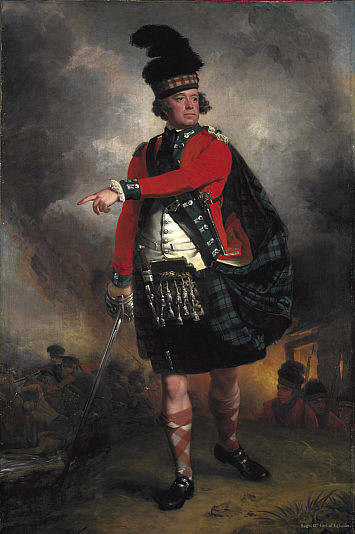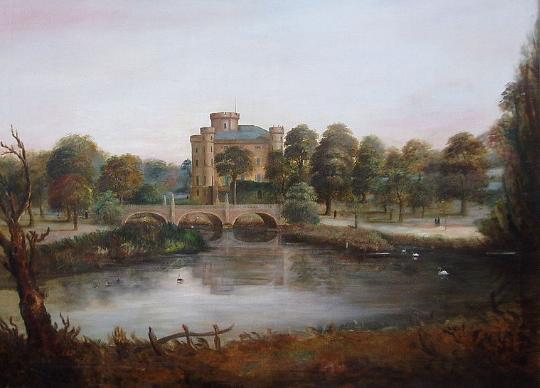|
THE EGLINTON CLAIM
The Service of the
Earl of Eglinton
as
Heir-Male General, and Heir-Male of Provision
to
George, the Fourth Earl of Winton, Lord Seton, and Tranent.
 In 1840 the Earl of Eglinton was served “nearest and lawful
heir male general, and also nearest and lawful heir male of
provision to George, fourth earl of Wintoun,” the eleventh Lord
Seton, and also Lord Tranent. This service took place before the
sheriff of Edinburgh, and a distinguished jury, composed of
members of the peerage, several of the judges of the court of
session, and of baronets and gentlemen eminently qualified for
legal and genealogical investigation. In 1840 the Earl of Eglinton was served “nearest and lawful
heir male general, and also nearest and lawful heir male of
provision to George, fourth earl of Wintoun,” the eleventh Lord
Seton, and also Lord Tranent. This service took place before the
sheriff of Edinburgh, and a distinguished jury, composed of
members of the peerage, several of the judges of the court of
session, and of baronets and gentlemen eminently qualified for
legal and genealogical investigation.
The evidence laid before the jury
was prepared in the same strict and elaborately comprehensive
manner as if it had been necessary to submit it to the scrutiny
of a Committee of Privileges in the House of Lords. Lord
Eglinton produced the most ample and satisfactory proof, not
only of his own propinquity, and of the extinction of all who
were entitled to succeed before him, but also of the extinction
of every collateral male descendant, remote as well as
immediate, of any of the parties who could in any way have laid
claim to the honours preferably to his lordship. A printed
abstract of the whole of the documentary evidence, which was of
great length, was, along with a detailed genealogical table,
laid before the jury, who thus judicially ascertained his right
to the male representation of the house of Wintoun, Seton and
Tranent, and the other honours which were so long held by that
noble family.
Although Lord
Eglinton derives his descent in the Montgomerie line from
ancestors of Norman origin, and through names distinguished in
the battles of Hastings and of Otterburn, and by virtue of that
descent enjoys the Eglinton honours and estates, -- in lineal
male descent from a period equally remote, and through a line of
loyal and patriotic ancestors, his family name is also that of
Seton, and he is the head of the numerous noble and eminent
families who claim to be descended from the Setons in the male
line.
The Wintoun
honours, destined in the first instance to heirs male, were
forfeited by the fifth Earl, in consequence of being engaged in
the rebellion of 1715. This attainder had the effect of
forfeiting absolutely the estates to the crown. But, as settled
by the judgment of the House of Lords, in the case of Gordon of
Park, adjudged by Lord Hardwicke, and recognized in many
subsequent cases, the right to the honours was only in abeyance
during the existence of the attainted Earl, and the heirs
entitled to succeed under the same substitution with himself.
Accordingly, the right to the honours, which was merely
suspended for a time, revived in the collateral branch of
Eglinton, in consequence of the failure of all the prior
branches in the direct Winton line.
The
representation of the family of Winton devolved upon the Earl of
Eglinton in consequence of the marriage in 1582 of Robert the
first Earl of Winton with Lady Margaret Montgomerie, eldest
daughter of Hugh third Earl of Eglinton. Of that marriage the
third son, Sir Alexander Seton of Foulstrouther, was adopted
into the family, -- became sixth Earl of Eglinton, and in 1615
obtained royal grants and confirmations of the estates and
honours of Montgomerie. The present Earl of Eglinton is the heir
male of the body of this Sir Alexander Seton, afterwards Earl of
Eglinton, and in consequence of the failure of the direct Winton
line by the death of Robert the eldest brother without issue,
and of all the male descendants of George the next or immediate
elder brother of Sir Alexander, Lord Eglinton is also the lineal
male representative of the family of Seton.
The origins of the Montgomeries began with Roger de
Montgomery, Earl of Shrewsbury (d. 1094), one of William the
Conqueror’s followers, and though this won't bear examination,
the sure pedigree of the family begins later with Sir John
Montgomerie, Lord of Eaglesham, who fought at the Battle of
Otterbourne in 1388 and died about 1398.
His grandson, Sir Alexander
Montgomerie (d. circa 1460), was made a Lord of the Scottish
parliament about 1445 as Lord Montgomerie, and Sir Alexander’s
great-grandson Hugh, the 3rd Lord (c. 1460-1545), was created
1st Earl of Eglinton, or Eglintoun, in 1508. The 3rd Earl
of Eglinton was a firm supporter of Mary queen of Scots for whom
he fought at Langside, and in 1612, by the death of Hugh, the
5th Earl, the direct male line of the Montgomeries became
extinct.
 Having no children Earl Hugh had
settled his title and estates on his cousin, Sir Alexander Seton
of Foulstruther (commonly called Greysteel, 1588-1661), a
younger son of Robert Seton, 1st Earl of Winton (c. 1550-1603),
and his wife Margaret, daughter of the 3rd Earl of Eglinton. Having no children Earl Hugh had
settled his title and estates on his cousin, Sir Alexander Seton
of Foulstruther (commonly called Greysteel, 1588-1661), a
younger son of Robert Seton, 1st Earl of Winton (c. 1550-1603),
and his wife Margaret, daughter of the 3rd Earl of Eglinton.
This succession was not without
contention, and King James VI personally intervened and
objected. It was only through the negotiation and the
influence of Alexander Seton, 1st Earl of Dunfermline and
Chancellor of Scotland, and the Earl of Winton that Alexander Seton of Foulstruther was
able to become the 6th Earl of Eglinton.
However, the
arrangement precluded that he and his heirs take the name of Montgomerie for that family line to continue,
never again to be called "Seton".
Sir Alexander became a
prominent Covenanter and fought against Charles I at Marston
Moor, creating for sometime, enmity between his family and that
of the Seton's of the Winton line.
Archibald William, the 13th Earl was
born at Palermo in the 29th of September 1812. He was a
staunch Tory, and in February 1852 he became Lord-Lieutenant of
Ireland. With the death of George Seton of Bellingham and
his legal claim to the Winton Honours gone, in 1859 Eglinton
successfully petitioned Her Majesty Queen Victoria as heir-male
to the Seton's Winton Honours.
Within the same year, his claim was
recognized and he was created 1st Earl of Winton within the
United Kingdom as a new creation. The Earldom which had been
held by his kinsfolk, the Setons, was within the Scottish
Peerage and which had ended with the forfeiture of George Seton,
5th Earl of Winton.
The Earls of Eglinton continued the
Seton's Templarist traditions, later continued in Freemasonry,
and were Grand Masters of the Grand Lodge in Scotland (and the
Order of the Temple). Alexander Montgomerie, 10th Earl of
Eglinton, was Knight of the Red Feather in the 18th century and
who passed the Ceremonial Sword onto Lord Kilmarnock, and was
Grand Master of the Grand Lodge following shortly after Hugh
Seton of Touch, in 1750-51. Archibald Seton Montgomerie,
16th Earl of Eglinton and 4th Earl of Winton was Grand Master in
1920-21, and Archibald Montgomerie, 17th Earl of Eglinton and
5th Earl of Winton was Grand Master from 1957 to 1961.
The present head of the family is
Archibald George Montgomerie, 18th Earl of Eglinton and 6th Earl
of Winton (UK). | 